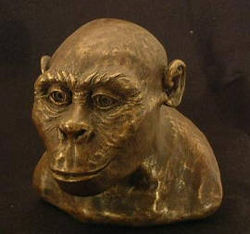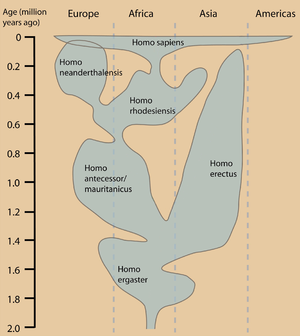- Hominin
-
Hominini
Hominins

Australopithecus africanus Classification classique Règne Animalia Embranchement Chordata Sous-embr. Vertebrata Classe Mammalia Sous-classe Theria Infra-classe Eutheria Ordre Primates Sous-ordre Haplorrhini Infra-ordre Simiiformes — non-classé — Catarrhini Super-famille Hominoidea Famille Hominidae Sous-famille Homininae Tribu Hominini
E. Delson & P. Andrews, 1975Sous-tribus de rang inférieur Parcourez la biologie sur Wikipédia : Les hominins constituent la tribu de la famille des hominidés incluant la tribu des hominines (à savoir les humains et les espèces disparues, comme les australopithèques, qui leur sont apparentées) ainsi que celle des panines (les chimpanzés)[1].
Sommaire
Systématique
Les chimpanzés, génétiquement très proches des humains bien que sensiblement différents par leur morphologie, sont classés chez les Hominini. Certains auteurs plaident pour le regroupement de l'ensemble des hominins sous le genre Homo[2].
Cladogramme
Hominoidea Hylobatidae (gibbons)
Hominidae Ponginae Homininae Gorillini Hominini Panina Hominina Australopithecus† et Homo (humains)
Etablir la phylogénie des différents fossiles d'hominins reste un travail assez spéculatif, car les fossiles sont fragmentaires et sans matériel génétique exploitable pour les australopithèques ou les premiers hommes.
Il est néanmoins raisonnable de considérer une lignée humaine, au côté d'une lignée de paranthropes, se connectant sur l'axe Australopithecus afarensis - Australopithecus africanus comme proposé par l'arbre ci-dessous, qui doit être considéré comme simplement indicatif[3], [4]. Les bifurcations exactes de ces lignées ou de spécimens comme Australopithecus bahrelghazali ou Australopithecus garhi restent hypothétiques.
└─o Catarrhini (singes de l'Ancien Monde) ├─o Cercopithecidae └─o Hominoidea ├─o Hylobatidae (Gibbons) └─o Hominidae ├─o Ponginae (Orang-outans) └─o Homininae ├─o Gorillini (Gorilles) └─o Hominini ├─o Sahelanthropus*† ├─o Orrorin*† └─o (env. –5,4 Ma) ├─? Ardipithecus kadabba† (–5,8 à –5,2 Ma) ├─o Panina (Chimpanzés) │ ├─o Pan troglodytes │ └─o Pan paniscus └─o Hominina ├─? Ardipithecus ramidus†[5] (–? à –4,4 Ma) ├─o Australopithecus anamensis† (–4,2 à –3,8 Ma) ├─? Australopithecus bahrelghazali*† (–3,5 à –3 Ma) ├─o │ ├─o Australopithecus afarensis† (–4,1 à –3 Ma) │ └─o └─? │ ├─┼─o Kenyanthropus platyops*† (env. –3,4 Ma) │ ├─o Australopithecus africanus† (–3,5 à –2,5 Ma) │ ├─? Australopithecus garhi*† (–2,6 Ma) │ └─o │ ├─o Paranthropus │ │ ├─o Paranthropus aethiopicus*† (–2,7 à –2,3 Ma) │ │ └─o │ │ ├─o Paranthropus boisei† (–2,4 à –1,2 Ma) │ │ └─o Paranthropus robustus† (–1,8 à –1,5 Ma) │ └─o Homo └─o │ └───?─o Homo rudolfensis*† (–2,4 à –1,8 Ma) ├─? Homo habilis*† (–2,2 à –1,6 Ma) ├─? Homo georgicus† (–1,8 à –1,2 Ma) └─o ├─o Homo ergaster† (–1,9 à –1 Ma) └─o ├─o Homo erectus† (–1 Ma à –300 ka) └─o ├─o Homo antecessor† (–1,2 Ma à –700 ka) └─o (env. –600 ka) ├─o │ ├─o Homo heidelbergensis† (–600 à –200 ka) │ └─o Homo neanderthalensis† (–250 à –28 ka) └─o ├─o Homo rhodesiensis† (–300 à –125 ka) └─o Homo sapiens (actuel) légende : † éteint, * espèce peu représentée ou discutée
Groupe frère
Dates de divergence
Les Hominini se sont différenciés des Gorillini il y a environ 6.4 Ma[6].
Les hominines se sont différenciés des panines entre –5.4 à –6.3 Ma.
Liste des hominins
- Premiers hominins
- Sahelanthropus tchadensis > (-7 Millions d'années), espèce à laquelle appartient le fossile surnommé « Toumaï. »
- Orrorin tugenensis > (-6 Millions d'années)
- Ardipithecus kadabba > (-5,8 à -5,2 Millions d'années)
- Ardipithecus ramidus > (-5,8 à -4,4 millions d'années)
- Hominina
- Kenyanthropus platyops > (-3,5 à -3,2 Millions d'années)
- Australopithèques graciles (groupe paraphylétique)
- Australopithecus anamensis > (-4,2 à -3,8 Millions d'années)
- Australopithecus afarensis > (-4,1 à -3 Millions d'années), espèce à laquelle appartient le fossile surnommé « Lucy » (syn. Praeanthropus africanus).
- Australopithecus bahrelghazali (-3,5 à - 3 Millions d'années), espèce à laquelle appartient le fossile surnommé « Abel ».
- Australopithecus africanus > (-3,5 à -2,5 Millions d'années)
- Australopithecus garhi > (-2,6 Millions d'années)
- Paranthropes ou australopithèques robustes
- Australopithecus aethiopicus > (-2,7 à -2,3 Millions d'années)
- Australopithecus boisei > (-2,4 à -1,2 Millions d'années)
- Australopithecus robustus > (-1,8 à -1,5 Millions d'années)
- représentants du genre Homo
- Homo rudolfensis > (-2,4 à -1,8 Millions d'années)
- Homo habilis > (-2,4 à -1,6 Millions d'années), l'humain habile
- Homo georgicus > (-1,8 à -1,2 Millions d'années), probablement le premier représentant du genre Homo hors d'Afrique.
- Homo ergaster > (-1,9 à -1 Million d'années), l'humain industrieux
- Homo antecessor > (-1,2 Millions d'années à -700 000 ans), l'humain avant-coureur
- Homo erectus > (-1 Million d'années à -300 000 ans), l'humain érigé
- Homo heidelbergensis > (-600 000 à -200 000 ans), l'humain de Heidelberg
- Homo helmei > (-500 000 à 300 000 ans)
- Homo neanderthalensis > (-250 000 à -28 000 ans), l'humain de Neanderthal
- Homo sapiens idaltu > (-195 000 à -154 000 ans)
- Homo rhodesiensis > (-300 000 à -125 000 ans), l’humain de Rhodésie.
- Homo floresiensis > (-95 000 à -12 000 ans), l'humain de Flores.
- Homo soloensis > (-95 000 à -12 000 ans)
- Homo sapiens > (-200 000 ans à nos jours), l'humain actuel ou « humain sage ».
Notes et références
- ↑ (en) J. Shoshani, C.P. Groves, E.L. Simons et G.F. Gunnell, « Primate phylogeny: morphological vs. molecular results », dans Mol Phyl. Evol., vol. 5, no 1, 1996, p. 102-54 [texte intégral].
- ↑ (en) Morris Goodman, Calvin A. Porter, John Czelusniak, Scott L. Page, Horacio Schneider, Jeheskel Shoshani, Gregg Gunnell et Colin P. Groves, « Toward a Phylogenetic Classification of Primates Based on DNA Evidence Complemented by Fossil Evidence », dans Molecular Phylogenetics and Evolution, vol. 9, no 3, juin 1998, p. 585–598 [[pdf] texte intégral (page consultée le 25 février 2009)].
- ↑ [1]
- ↑ [2]
- ↑ (en) Yohannes Haile-Selassie, Gen Suwa et Tim D. White, « Late Miocene Teeth from Middle Awash, Ethiopia, and Early Hominid Dental Evolution », dans Science, vol. 303, no 5663, 2004, p. 1503–1505 [lien PMID lien DOI].
- ↑ Stauffer et al., 2001, Houman and apes molecular clocks and constraints on paleontological hypothesis
Voir aussi
- Portail de la zoologie
Catégories : Hominini | Paléoanthropologie - Premiers hominins
Wikimedia Foundation. 2010.


